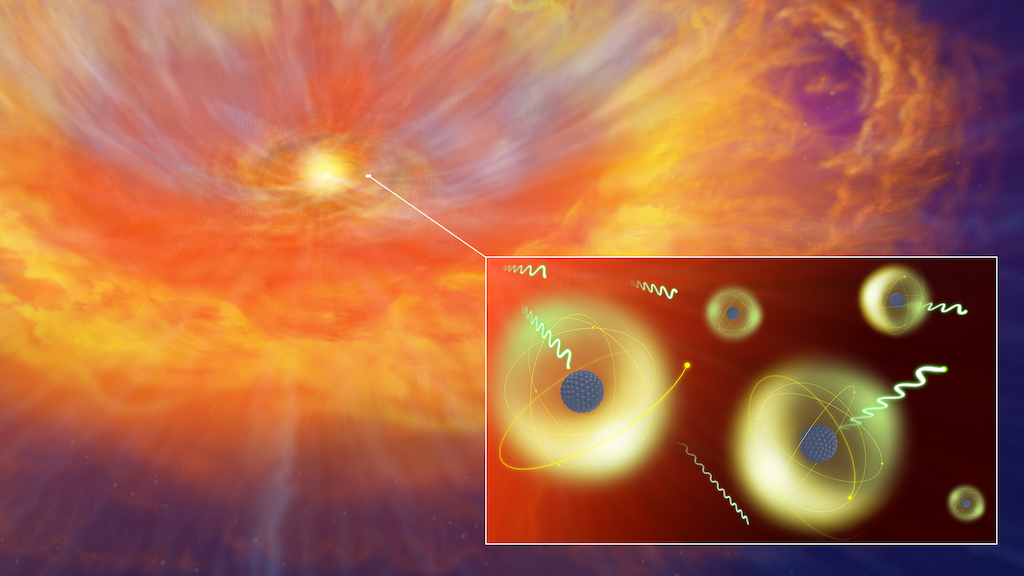A team of experts in nuclear fusion and astronomy has computed high-accuracy atomic data for analyzing light from a kilonova, a birth place of heavy elements. They found that their new data set could predict kilonovae brightness with much better accuracy than before. This aids our understanding of the cosmic origins of heavy elements.

Image of a kilonova and heavy elements (3840 × 2160 pixels) : [color (JPG, 1.81 MB)],[grey (JPG, 1.27 MB)]
Image of heavy elements (1920 × 1080 pixels) : [color (JPG, 688 KB)],[grey (JPG, 499 KB)]
Atoms and ions can absorb and emit certain colors of light. By analyzing the detailed colors of inaccessible objects, like high temperature plasmas in a fusion chamber or distant stars, scientists can identify their elemental abundances. This analysis needs atomic data about the wavelengths of light absorbed and emitted by each element. But there is no comprehensive, accurate atomic data for the heavy elements which are thought to be formed in kilonovae.
A team led by Daiji Kato, Associate Professor at the National Institute for Fusion Science (NIFS) in Japan, and Gediminas Gaigalas, Professor at Vilnius University in Lithuania, applied methods from nuclear fusion research to compute millions of highly accurate atomic data for neodymium ions. Neodymium is one of the important elements for kilonovae radiation, and is well studied by experiments and simulations. “The atomic structure of neodymium is more complicated than those of lighter elements, such as iron, calculated for nuclear fusion science. We needed to extend and optimize our calculation methods for such an element with such complicated structures,” Kato said.
When two neutron stars collide they break apart, spewing waves of unstable nuclear material into space. This material rapidly decays causing radioactive afterglow known as a kilonova. Scientists believe that the nuclear reactions in neutron star mergers could be one of the primary sources for the heavy elements, including precious metals such as gold and platinum, and rare earth metals such as neodymium.
The neodymium atomic data computed by the Japan-Lithuania team agree with the experimental data far better than any other calculations have done. An astronomer in the research group, Masaomi Tanaka, Associate Professor at Tohoku University simulated the light of a kilonova with a supercomputer at the National Astronomical Observatory of Japan (NAOJ) using new atomic data, and for the first time in the world, he could evaluate the influence of the database precision on the predicted brightness of a kilonova. He found that the answer varied by about 20% at most, which is sufficiently accurate to give astronomers confidence in their interpretation of kilonova observations. By calculating atomic data for other metals with this method developed in fusion science, the detail abundances of cosmic heavy elements formed by kilonovae will come to light.
These research results were published as Gaigalas et al. "Extended Calculations of Energy Level and Transition Rates of Nd II-IV Ions for Application to Neutron Star Mergers" in the Astrophysical Journal Supplement Series in February 2019. For calculations for new atomic data, parallel computers of NIFS and a massive computer “HPC Sauletekis” at Vilnius University were used. For kilonova simulations using the new atomic data, NAOJ’s supercomputers “ATERUI” and “ATERUI II” were used.
(March 12, 2019 Press Release)
[ Paper Details ]
Title: "Extended Calculations of Energy Levels and Transition Rates of Nd II-IV Ions for Application to Neutron Star Mergers"
Journal: The Astrophysical Journal Supplement Series
Author: Gediminas Gaigalas1, Daiji Kato2,3, Pavel Rynkun1, Laima Radžiūtė1, Masaomi Tanaka4
1) Institute of Theoretical Physics and Astronomy, Vilnius University, 2) National Institute for Fusion Science, 3) Department of Advanced Energy Engineering Science, Kyushu University, 4) Astronomical Institute, Tohoku University
DOI:10.3847/1538-4365/aaf9b8
This research was funded by a grant (No. S-LJB-18-1) from the Research Council of Lithuania. This research was also supported by the JSPS Bilateral Joint Research Project, the NINS program of Promoting Research by Networking among Institutions (grant No. 01411702), the NINS program for cross-disciplinary science study, Inoue Science Research Award from Inoue Foundation for Science, and the Grant-in-Aid for Scientific Research from JSPS (15H02075, 16H02183) and MEXT (17H06363).
[For the Use of Contents in This Website]
- Contents are to be used with a clear indication of its copyright (e.g. (c) NAOJ.)
- If you would like to use the contents found in this web site, please follow Terms of Use of the Website of NAOJ.
[Related Links]
NIFS Press Release "Fusion Science and Astronomy Collaboration Enables Investigation of the Origin of Heavy Elements"
NAOJ Press Release "Cross-Disciplinary Collaboration Enables Investigation of the Origin of Heavy Elements"
